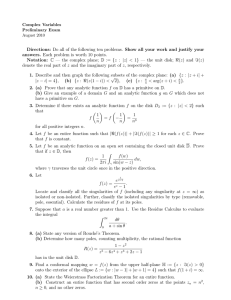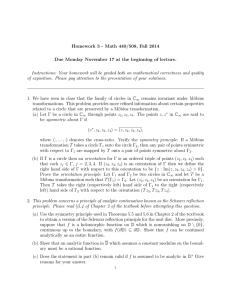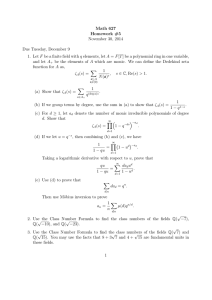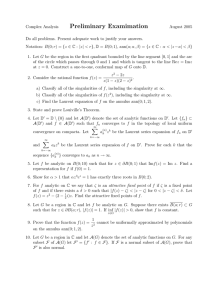Problem Set 3 - Math 440/508, Fall 2011
advertisement
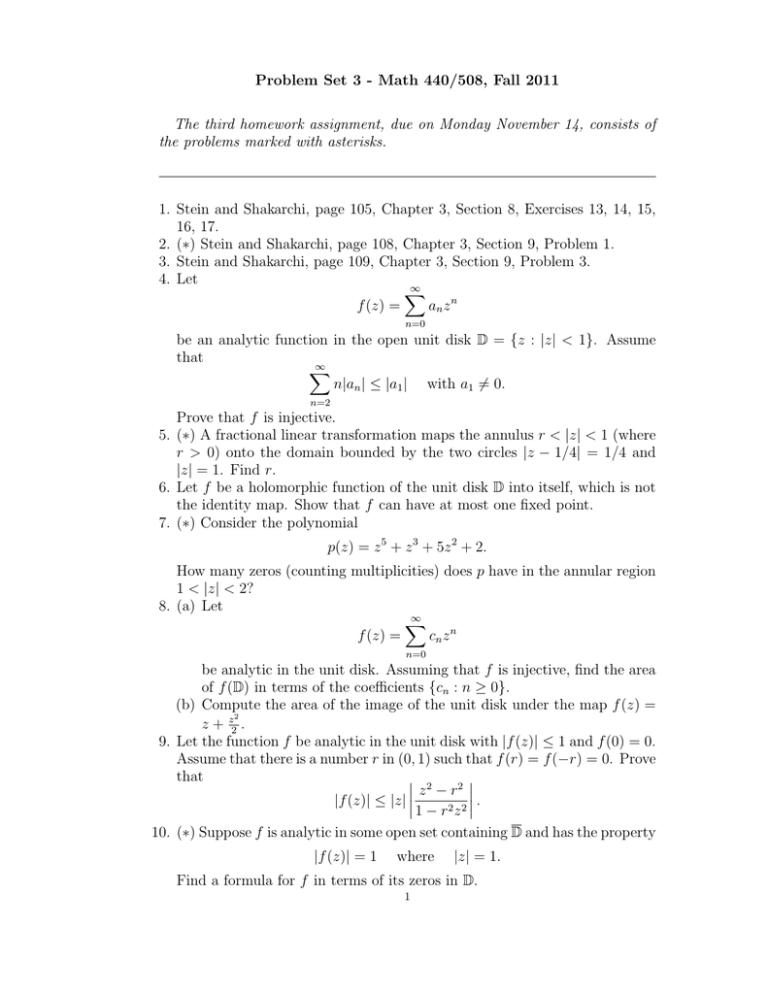
Problem Set 3 - Math 440/508, Fall 2011
The third homework assignment, due on Monday November 14, consists of
the problems marked with asterisks.
1. Stein and Shakarchi, page 105, Chapter 3, Section 8, Exercises 13, 14, 15,
16, 17.
2. (∗) Stein and Shakarchi, page 108, Chapter 3, Section 9, Problem 1.
3. Stein and Shakarchi, page 109, Chapter 3, Section 9, Problem 3.
4. Let
∞
X
f (z) =
an z n
n=0
be an analytic function in the open unit disk D = {z : |z| < 1}. Assume
that
∞
X
n|an | ≤ |a1 | with a1 6= 0.
n=2
Prove that f is injective.
5. (∗) A fractional linear transformation maps the annulus r < |z| < 1 (where
r > 0) onto the domain bounded by the two circles |z − 1/4| = 1/4 and
|z| = 1. Find r.
6. Let f be a holomorphic function of the unit disk D into itself, which is not
the identity map. Show that f can have at most one fixed point.
7. (∗) Consider the polynomial
p(z) = z 5 + z 3 + 5z 2 + 2.
How many zeros (counting multiplicities) does p have in the annular region
1 < |z| < 2?
8. (a) Let
∞
X
cn z n
f (z) =
n=0
be analytic in the unit disk. Assuming that f is injective, find the area
of f (D) in terms of the coefficients {cn : n ≥ 0}.
(b) Compute the area of the image of the unit disk under the map f (z) =
2
z + z2 .
9. Let the function f be analytic in the unit disk with |f (z)| ≤ 1 and f (0) = 0.
Assume that there is a number r in (0, 1) such that f (r) = f (−r) = 0. Prove
that
2
z − r2 .
|f (z)| ≤ |z| 1 − r2 z 2 10. (∗) Suppose f is analytic in some open set containing D and has the property
|f (z)| = 1
where
|z| = 1.
Find a formula for f in terms of its zeros in D.
1
2
11. (a) For |z| < 1 define f (z) by
(
12 )
1+z
f (z) = exp −i log i
.
1−z
Describe f (D).
(b) Discuss the mapping properties of (1 − z)i .
12. If G is a group and N is a subgroup then N is said to be a normal subgroup
of G if S −1 T S ∈ N whenever T ∈ N and S ∈ G. A group G is said to be
simple if the only normal subgroups of G are the trivial ones, namely the
identity and G itself. Prove that the group of Möbius transformations is a
simple group.
13. (a) Prove that there is no one-to-one conformal map of the punctured disc
G = {z ∈ C : 0 < |z| < 1} onto the annulus A = {z ∈ C : 1 < |z| < 2}.
(b) More generally, find a necessary and sufficient condition for two annuli,
both centered at the origin, to be conformally equivalent.
14. Let Γ be a circle through points z2 , z3 , z4 . The points z, z ∗ ∈ C∞ are said
to be symmetric about Γ if
(z, z2 , z3 , z4 ) = (z, z2 , z3 , z4 ).
(a) Give a geometric description of the relation between z and z ∗ . Does it
agree with your notion of symmetry about a straight line?
(b) Prove the symmetry principle: If a Möbius transformation T takes a
circle Γ1 to a circle Γ2 , then any pair of points symmetric with respect
to Γ are mapped by T onto a pair of points symmetric about Γ2 .
15. If Γ is a circle then an orientation for Γ is an ordered triple of point
(z1 , z2 , z3 ) such that zj ∈ Γ, j = 1, 2, 3. (Intuitively, these points give a
direction to Γ, why?). Given such an orientation, we define the right and
left side of Γ with respect to (z1 , z2 , z3 ) to be the sets
{z ∈ C : Im(z, z1 , z2 , z3 ) > 0} and {z ∈ C : Im(z, z1 , z2 , z3 ) < 0}
respectively.
Prove the orientation principle: Let Γ1 and Γ2 be two circles in C∞ and
let T be a Möbius transformation such that T (Γ1 ) = Γ2 . Let (z1 , z2 , z3 ) be
an orientation for Γ1 . Then T takes the right and left sides of Γ1 onto the
right and left sides of Γ2 with respect to the orientation (T z1 , T z2 , T z3 ).

